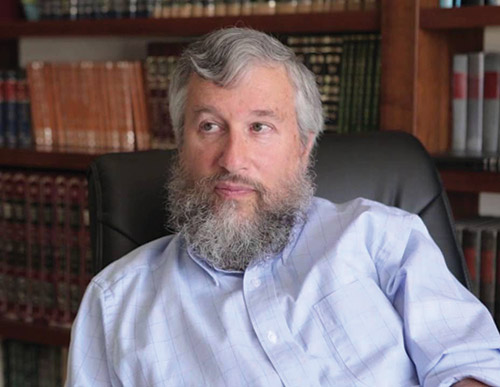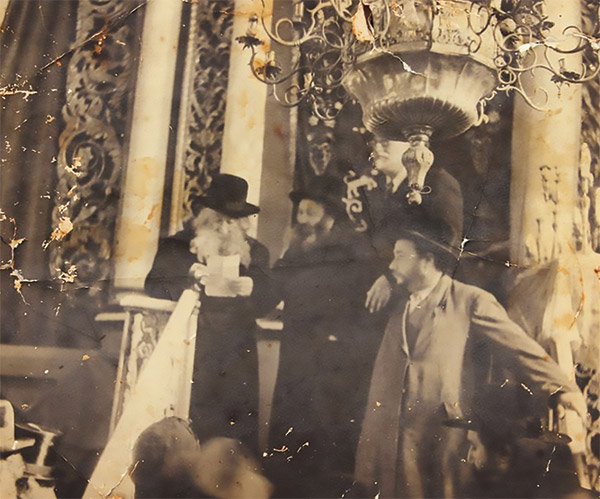When Heidi Met Shimen
Several years ago, a blog called Judaism Without Apologies began to circulate on social media. The blog began by juxtaposing two Jewish characters’ lives and ideals: Shimen, a Gerer Hasid of sorts and Holocaust survivor living on the Upper West Side of Manhattan, and Heidi, a cosmopolitan Princeton graduate who thinks of herself as a citizen of the world.
The series was narrated by the American Israeli computer scientist Moshe Koppel, who had attended Shimen’s Gerer shtiebel in his youth. After obtaining a PhD in mathematics, Koppel spent a year at Prince- ton’s Institute for Advanced Study, where he met the original Heidi, the first of many he would encounter in the years to come. Koppel’s blog may have been rooted in comic sociology, but it quickly morphed into a serious discussion of moral philosophy, game theory, cultural anthropology, the nature of language, and ultimately an argument about the future of Judaism itself. Despite its rather niche appeal, the blog’s unique fusion of a no-holds-barred attitude with serious erudition attracted some diehard fans. Koppel has just published an expanded book-length version, which presents a cleaned-up and even more compelling defense of the old-fashioned Judaism Koppel imbibed in the shtiebel.
Shimen, a real-life acquaintance of Koppel (Heidi is a composite), is at the heart of the book. He survived the Lodz Ghetto and Auschwitz, but his wife and two precious children did not. After the war, Shimen picked up a handgun and collected Jewish children who had been hidden by Polish families and returned them to their communities. Elie Wiesel, who prayed in Shimen’s Gerer shtiebel from time to time, once told a story about celebrating Rosh Hashanah in Auschwitz without wine. An inmate announced, “we’ll take out tin cups and fill them with tears. And that is how we’ll make our kiddush . . . heard before God.” That, apparently, was Shimen. Koppel writes of Polish Hasidic Holocaust survivors like him:
[They] were intense, they were angry, they could be funny in a biting sort of way. . . . But one thing they had no patience for was high-minded pieties. They despised pomposity and self-righteousness. Their devotion to Yiddishkeit, old-fashioned Judaism, as a way of life, and to the Jews as a people, were as natural and instinctive as drawing breath.
Shimen was no longer a full-fledged Hasid by the time Koppel got to know him, yet he nevertheless lived a life filled with attention to the halakhic details and time-honored rituals of Orthodox Judaism. These constitute Shimen’s rich system of “social norms”—inherited wisdom, developed and refined over centuries, necessary for any community to cohere and thrive. Moreover, the content of these norms—he would call it Yiddishkeit—formed a kind of “first language” for Shimen, a way of being rather than a theological position. To illustrate the difference, Koppel recalls the story of the famed apikoros (heretic) of Warsaw that illustrates how irrelevant ideology can be in the life of a traditional Jew. He is visited by a younger apikoros who wants to see how the famed heretic observes Shabbat:
Much to his surprise, he endures a long Shabbat during which the old apikoros observes every ritual and every restriction down to the last detail. He expresses his astonishment, and when the old apikoros asks what he expected, he responds that he expected the old fellow to wantonly violate the Shabbat rules. “Why should I do that?” asks the old apikoros. “What do you mean? Lehakhis!”—out of spite. With a bewildered look, the old apikoros simply shrugs and says, “To spite Whom?”

Heidi, a character more familiar to most American Jews, is the grandchild and great-grandchild of men similar to Shimen. She grew up in a Conservative Jewish home on Long Island, but in college, she came to disdain the non-egalitarian, particularist aspects of Judaism. Heidi is drawn to the political philosophy of John Rawls, which presupposes the possibility of the “unencumbered self,” an identity that precedes any cultural or religious commitments. Heidi also trusts experts and believes that rational scientific expertise, not tradition, is the key to a flourishing society. She strives for objectivity and has come to see Judaism as simply one form of tribalism among many.
Koppel describes meeting Heidi in the kosher dining hall at Princeton, where she takes it upon herself to educate him about the “special duties” of the Jewish people to humankind:
How can you justify your narrow tribal loyalty? Isn’t the lesson of the Holocaust that we Jews must never put our parochial interests ahead of others’ interests? We should know better than anyone what happens when that lesson isn’t learned.
At the time, Koppel was unable to respond to her. Despite his uppercase Orthodox Jewish upbringing, he writes, until he met an ideologue like Heidi, he “had never encountered true orthodoxy before.” Judaism Straight Up is his belated answer.
To make sense of Heidi’s worldview and to contrast her with Shimen, Koppel harnesses the anthropologist Richard Shweder’s theory of the three major moral foundations of society: fairness, restraint, and loyalty. Shimen’s version of Judaism, he writes, “has settled upon a somewhat delicate balance between fairness, on the one hand, and restraint and loyalty, on the other—often favoring the latter.” Heidi, by contrast, is all about fairness, and her inherited connection to Judaism is replaced by a refusal to prioritize any one culture over another (except, perhaps, insofar as one is the underdog). Heidi’s community is thus relatively weak, centered more upon political preferences and educational and professional achievements than on kinship, ethnicity, or shared history and social norms. Shimen’s fluency in the “first language” of Yiddishkeit means that:
he can walk into a Gerer shtiebel anywhere in the world and find people who remember his family, who share friends and acquaintances with him, who speak his dialect, who know what he knows, who understand what he needs.
Heidi, on the other hand, “can walk into a progressive conclave and find people who share with her a passion for fair-trade coffee and a fear of Republicans.”
Proof of the weakness of Heidi’s worldview is in the intergenerational pudding. Even Heidi’s daughter Amber, a left-wing activist, does not share her mother’s tolerant “live and let live” values. Heidi’s prioritization of fairness above all other moral foundations ends up undermining even the value of fairness itself, since, as Koppel remarks, “to love everybody equally is to love nobody.” Moreover, such ideals are difficult to pass on (radical Amber is not a Rawlsian). In truth, even Heidi herself fails to live up to her lofty ideals, especially when it comes to her attitude toward religious Jews:
If some New Jersey township were hunting for ways to keep American Vulcans with pointy ears and quaint traditions from flooding into their neighborhood and acting altogether like Vulcans, Heidi would be leading demonstrations against the troglodytes. But when American Hasidim with curly earlocks and quaint traditions wish to move into her neighborhood, she’s more likely to be found on the other side of the barricades.
Koppel has plenty of fun at the expense of his avatars. Yet his goal is not really to paint Shimen (who is long dead) as superior to Heidi, Amber, and the rest. First of all, it may well not be possible since, for someone like Shimen, “Jewish belief is only coherent and meaningful to those already committed to the Jewish way of life, who experience its vitality viscerally.” Neither Shimen nor Koppel is interested in a “why be Jewish” treatise that explains and defends the beauty of Jewish tradition. Koppel doesn’t whitewash those parts of Shimen’s Judaism that might seem bizarre or problematic to the uninitiated: the apparent tribalism and patriarchy, not to speak of the occasional consumption of p’tcha (calf’s-foot jelly).
Rather, Koppel’s point is that a certain balance between freedom and loyalty, between universalism and particularism, between creativity and commitment, needs to be in place for any society to be viable and endure. Maintaining this balance should be as intuitive and natural as speaking a language. Like language, it can thus develop and evolve organically without too much self-conscious tinkering by authorities. Shimen, the cranky, old-fashioned Polish Jew, maintains a kind of cultural equilibrium without even knowing it. Heidi, and others like her, have upset this balance without quite understanding what they’ve lost. She may be able to coast on some of the Jewish sensibilities with which she was raised, but, ultimately, her cosmopolitanism doesn’t have enough substance to pass on to the next generation. Or, as Koppel puts it, “Heidi’s world is doomed.”
If Heidi’s way of life is doomed, it’s not clear what Shimen’s legacy is going to look like either, especially in the United States. Shimen’s actual children are dead, and his figurative heirs don’t seem to possess the sort of comfort in their own skin that Shimen does. “Let’s face it,” writes Koppel:
What was special about Shimen and his cronies was, to some extent, the product of very specific and tragic circumstances. They had lived in a closed world and then seen it destroyed. On the one hand, their Yiddishkeit was deeply ingrained and fully internalized; on the other hand, having been robbed of their families and communities, they were as independent and self-determining as human beings could be.
Despite his clear sympathy for Shimen’s way of life, Koppel himself does not spend his time in New York City shtieblach; he moved to Israel years ago. In addition to his work as a professor of computer science at Bar-Ilan University, he is the founder of the Kohelet Policy Forum, arguably the most influential conservative think tank in Israel today. (He is also on the board of directors of the Tikvah Fund, which supports the Jewish Review of Books.) Koppel’s Kohelet has been influential in passing several Knesset bills, including the recent, controversial nation-state law. He is quietly among the most influential nonpoliticians in Israel. Yet, for reasons that are not quite clear even to Koppel himself, he views the world through the eyes of Shimen the Gerer Hasid. Where, then, do Israel and Zionism fit into this worldview?

As he had with Heidi’s daughter Amber, Koppel adds a new generation of characters to Shimen’s world. Yitzy and Ben are Shimen’s relatives who grew up in Brooklyn. These cousins somewhat arbitrarily end up on different ends of the haredi–Modern American Orthodox Jewish spectrum. And yet both of them suffer from a similar problem: Judaism is really their second language, not their first. Yitzy, the black-hatter from Brooklyn, adopts arcane, unknown-to-Shimen halakhic stringencies based on readings of rabbinic texts rather than inherited wisdom. Both his wardrobe choices and his decision to deprive his children of a basic secular education are rooted in a desire to distance himself and his family from their secular surroundings rather than a profound commitment to Torah values. Ben, the Ivy League–trained lawyer, is privately embarrassed over his community’s provincialism and drags halakha in his preferred direction, towards Heidi’s world, even when doing so is intellectually dishonest. Yitzy and Ben’s hyperawareness of their American context—whether to reject it or to accommodate it—and their overemphasis on cultural signaling at the expense of substance distance them from the organic Judaism that Shimen effortlessly breathes. I find Koppel to be a little hard on Ben and even more so on Yitzy. I know plenty of decent people just like them, and they are trying to make their way through a complicated, discordant world. But his essential point remains, and he states it without apology:
Even the most well-integrated committed Jews in America live compartmentalized lives. They play successfully to two audiences, but never quite at the same time. . . . For the most part, the Yitzies will produce more Yitzies behind ever higher walls and the Bens will produce Heidis who produce Ambers. None will produce Shimens.
Shimen himself only makes it to Israel to be buried on the Mount of Olives. Yet Israel is where Koppel sees the potential for organic Judaism to take root and flourish. Israel has its problems, to be sure, including its own version of compartmentalization. This Koppel explores through another set of imaginary characters: Adi, Heidi’s Israeli counterpart, a snobby civil servant who resents the influence of religious parties in Israel; Itcha Meir, a contemporary Gerer Hasid who refuses army service and gainful employment; and Bentzi, a student of Rabbi Zvi Yehuda Kook, who views the modern Jewish state with starry-eyed idealism.
Whereas Heidi and her woke progeny scatter in the winds of the American landscape and the heirs of Yitzy and Ben find themselves growing further apart, their Israeli counterparts find themselves socializing together, mostly serving in the army together, and sharing a Jewish cultural vocabulary, which embraces keeping, or even just respecting, Shabbat, listening to pop music with biblical themes and allusions on the radio, watching films or reading books that are steeped in Jewish content, and so forth. None of this is possible, or even conceivable, in America. When Judaism is an organic, majority culture, a first language, change is naturally balanced by stasis, and personal freedom with a sense of collective purpose in a way that allows for continued viability into the future.
I think Koppel is basically right about this, but his attempt to depict modern Israel as a kind of resurrection of Shimen’s Yiddishkeit, even in the abstract, may be giving both short shrift. The portrait of Shimen in Judaism Straight Up is wonderful and ultimately quite moving. He is—or perhaps one should say was—a type that deserves to be better understood, and Koppel’s idiosyncratic blog-cum-book allows us to do so in a way that no academic study could. But Shimen’s identity is even less reproducible than Heidi’s since the world in which it was forged doesn’t exist anymore.
The State of Israel’s ability to foster a reality in which Judaism is the first language is clear to many; perhaps chief among them are those diaspora Jews who, like Koppel, made aliyah. But, for better or for worse, it is very far from Shimen’s shtiebel. Indeed, Israel may create a Jewish language as difficult to understand for diaspora Jews (let alone Shimen) as modern English would be to Chaucer. That is part of the peril and the promise of Zionism. One hopes that speakers of this future language will honor the legacy of Shimen and his generation even as they transform it in ways we still can’t fully grasp.
Suggested Reading

Spinoza in Shtreimels: An Underground Seminar
A professor and three Hasidim walk into a bar—to study philosophy. True story.
Swimming in an Inky Sea
Ilana Kurshan, a hyper-literary, ideologically egalitarian, hopeless romantic (in her words), doesn’t fit the typical profile of a Daf Yomi participant.

The Jewsraeli Century
Ben-Gurion declared that “with the creation of the state, we are standing on the edge of a new era. Not only in the life of the Jewish community in Israel, but . . . in the history of Judaism itself.” He was right, but not in the way he thought he would be.

Punctuality, Mendelssohn, and Nihilism: Remembering Alexander Altmann
Punctuality seemed like one of the requirements of working with a yekke, the kind of Central European Jew who wore a jacket and tie even if he had no plans to leave the house.
Comments
You must log in to comment Log In